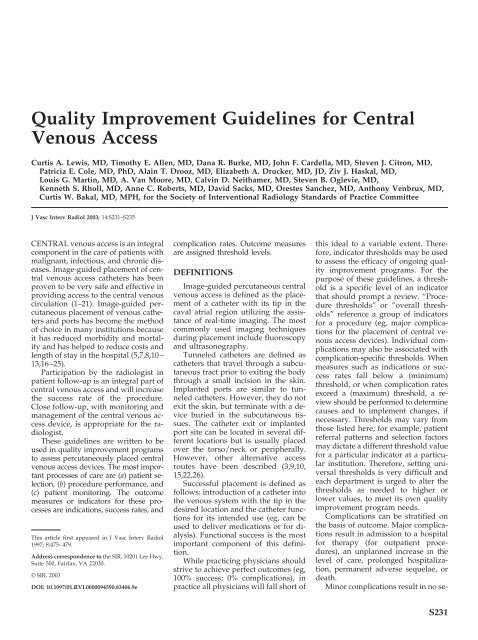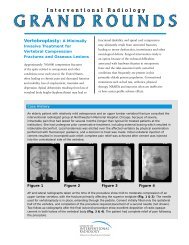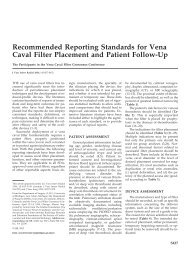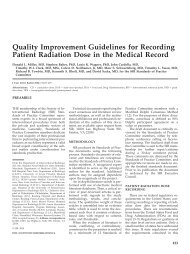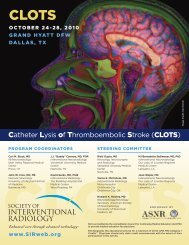Quality Improvement Guidelines for Central Venous Access
Quality Improvement Guidelines for Central Venous Access
Quality Improvement Guidelines for Central Venous Access
You also want an ePaper? Increase the reach of your titles
YUMPU automatically turns print PDFs into web optimized ePapers that Google loves.
<strong>Quality</strong> <strong>Improvement</strong> <strong>Guidelines</strong> <strong>for</strong> <strong>Central</strong><strong>Venous</strong> <strong>Access</strong>Curtis A. Lewis, MD, Timothy E. Allen, MD, Dana R. Burke, MD, John F. Cardella, MD, Steven J. Citron, MD,Patricia E. Cole, MD, PhD, Alain T. Drooz, MD, Elizabeth A. Drucker, MD, JD, Ziv J. Haskal, MD,Louis G. Martin, MD, A. Van Moore, MD, Calvin D. Neithamer, MD, Steven B. Oglevie, MD,Kenneth S. Rholl, MD, Anne C. Roberts, MD, David Sacks, MD, Orestes Sanchez, MD, Anthony Venbrux, MD,Curtis W. Bakal, MD, MPH, <strong>for</strong> the Society of Interventional Radiology Standards of Practice CommitteeJ Vasc Interv Radiol 2003; 14:S231–S235CENTRAL venous access is an integralcomponent in the care of patients withmalignant, infectious, and chronic diseases.Image-guided placement of centralvenous access catheters has beenproven to be very safe and effective inproviding access to the central venouscirculation (1–21). Image-guided percutaneousplacement of venous cathetersand ports has become the methodof choice in many institutions becauseit has reduced morbidity and mortalityand has helped to reduce costs andlength of stay in the hospital (5,7,8,10–13,16–25).Participation by the radiologist inpatient follow-up is an integral part ofcentral venous access and will increasethe success rate of the procedure.Close follow-up, with monitoring andmanagement of the central venous accessdevice, is appropriate <strong>for</strong> the radiologist.These guidelines are written to beused in quality improvement programsto assess percutaneously placed centralvenous access devices. The most importantprocesses of care are (a) patient selection,(b) procedure per<strong>for</strong>mance, and(c) patient monitoring. The outcomemeasures or indicators <strong>for</strong> these processesare indications, success rates, andThis article first appeared in J Vasc Interv Radiol1997; 8:475–479.Address correspondence to the SIR, 10201 Lee Hwy,Suite 500, Fairfax, VA 22030.© SIR, 2003DOI: 10.1097/01.RVI.0000094590.83406.9ecomplication rates. Outcome measuresare assigned threshold levels.DEFINITIONSImage-guided percutaneous centralvenous access is defined as the placementof a catheter with its tip in thecaval atrial region utilizing the assistanceof real-time imaging. The mostcommonly used imaging techniquesduring placement include fluoroscopyand ultrasonography.Tunneled catheters are defined ascatheters that travel through a subcutaneoustract prior to exiting the bodythrough a small incision in the skin.Implanted ports are similar to tunneledcatheters. However, they do notexit the skin, but terminate with a deviceburied in the subcutaneous tissues.The catheter exit or implantedport site can be located in several differentlocations but is usually placedover the torso/neck or peripherally.However, other alternative accessroutes have been described (3,9,10,15,22,26).Successful placement is defined asfollows: introduction of a catheter intothe venous system with the tip in thedesired location and the catheter functions<strong>for</strong> its intended use (eg, can beused to deliver medications or <strong>for</strong> dialysis).Functional success is the mostimportant component of this definition.While practicing physicians shouldstrive to achieve perfect outcomes (eg,100% success; 0% complications), inpractice all physicians will fall short ofthis ideal to a variable extent. There<strong>for</strong>e,indicator thresholds may be usedto assess the efficacy of ongoing qualityimprovement programs. For thepurpose of these guidelines, a thresholdis a specific level of an indicatorthat should prompt a review. “Procedurethresholds” or “overall thresholds”reference a group of indicators<strong>for</strong> a procedure (eg, major complications<strong>for</strong> the placement of central venousaccess devices). Individual complicationsmay also be associated withcomplication-specific thresholds. Whenmeasures such as indications or successrates fall below a (minimum)threshold, or when complication ratesexceed a (maximum) threshold, a reviewshould be per<strong>for</strong>med to determinecauses and to implement changes, ifnecessary. Thresholds may vary fromthose listed here; <strong>for</strong> example, patientreferral patterns and selection factorsmay dictate a different threshold value<strong>for</strong> a particular indicator at a particularinstitution. There<strong>for</strong>e, setting universalthresholds is very difficult andeach department is urged to alter thethresholds as needed to higher orlower values, to meet its own qualityimprovement program needs.Complications can be stratified onthe basis of outcome. Major complicationsresult in admission to a hospital<strong>for</strong> therapy (<strong>for</strong> outpatient procedures),an unplanned increase in thelevel of care, prolonged hospitalization,permanent adverse sequelae, ordeath.Minor complications result in no se-S231
S232 • QI <strong>Guidelines</strong> <strong>for</strong> <strong>Central</strong> <strong>Venous</strong> <strong>Access</strong> September 2003 JVIRTable 1Indications <strong>for</strong> <strong>Central</strong> <strong>Venous</strong> <strong>Access</strong>Therapeutic IndicationsAdministration of chemotherapyAdministration of total parenteralnutritionAdministration of blood productsAdministration of intravenousmedicationsIntravenous fluid administrationPer<strong>for</strong>mance of plasmapheresisPer<strong>for</strong>mance of hemodialysisDiagnostic IndicationsTo establish or confirm a diagnosisTo establish a prognosisTo monitor response to treatmentFor repeated blood samplingTable 2Success RatesReported Rates(%)Threshold(%)Internal jugular approach (4,22,27–35) 96 95Subclavian vein approachCatheter (6,8,11,14,16,17,19,22,23,28,31–33,36–44) 95 90Infusion port (16,18,22,23,45) 95 90Peripherally inserted central catheters (PICC)96 90(1,7,20,22,23,25,46–51)Peripherally implanted ports96 90(2,5,10,12,13,16,21,23,24,48,52–57)Translumbar approach (9,15,26) 96 90Note.—Success rates and thresholds listed are <strong>for</strong> the adult population and could beexpected to be lower in a pediatric population.quelae; they may require nominal therapyor a short hospital stay <strong>for</strong> observation(generally overnight) (AppendixA). The complication rates and thresholdsbelow refer to major complications.INDICATIONS FOR CENTRALVENOUS ACCESSIndications <strong>for</strong> central venous accessare listed in Table 1. The threshold<strong>for</strong> these indications is 95%. Whenfewer than 95% of procedures are <strong>for</strong>these indications, the department willreview the process of patient selection.The decision to place a central venousaccess device should be madeafter considering the risks and benefitsto each patient. Coagulopathy andsepsis may be relative contraindicationsto immediate implantation oflong-term central venous access devices.Appropriate ef<strong>for</strong>t should bemade to correct or improve a patient’scoagulopathy prior to placement of acentral venous catheter. Other factorsthat may also increase complicationsinclude venous stenosis, acute thrombosis,and local skin infection at theinsertion site. In patients in whomthese findings or abnormalities cannotbe corrected, the procedure may stillbe indicated if the risk/benefit ratio islower than the alternative methods ofdiagnosis or treatment.SUCCESS RATES OF CENTRALVENOUS ACCESSSuccess rates <strong>for</strong> central venous accessare listed in Table 2, along withrecommended threshold values.Table 3Complication Rates and Suggested Thresholds <strong>for</strong> <strong>Central</strong> <strong>Venous</strong> <strong>Access</strong>Specific Major Complications<strong>for</strong> Image-guided<strong>Central</strong> <strong>Venous</strong> <strong>Access</strong>COMPLICATIONS OFCENTRAL VENOUS ACCESSComplications are defined as early(occurring within 30 days of placement)or late (occurring after 30 days).Early complications can be subdividedinto procedurally related, defined asthose that occur at the time or within24 hours of the intervention, and thoseoccurring beyond that period. Complicationsthat occur at the time of theprocedure usually consist of injury tothe surrounding vital structures ormalpositioning of the catheter tip. TheRate(%)SuggestedThreshold(%)Subclavian and jugular approachesPneumothorax 1–2 3Hemothorax 1 2Hematoma 1 2Per<strong>for</strong>ation 0.5–1 2Air embolism 1 2Wound dehiscence 1 2Procedure-induced sepsis 1 2Thrombosis* 4 8Peripheral placement PICC and peripheral portsPneumothorax/hemothorax 0 0Hematoma 1 2Wound dehiscence 1 2Phlebitis* 4 8Arterial injury 0.5 1Thrombosis* 3 6Procedure-induced sepsis 1 2* The literature is difficult to define, and most complications are thought not to bemajor complications.incidence of early complications islower with image-guided techniqueswhen compared to blind or externallandmark techniques (7,27,31,34,38,43).Complications (major and minor)occur in approximately 7% of patientswhen image guidance is used (7,11,14,18,20,31,37,39). Published complicationrates and suggested thresholdsare listed in Table 3.Published rates <strong>for</strong> individual typesof complications are highly dependenton patient selection and are based onseries comprising several hundred pa-
Volume 14 Number 9 Part 2Lewis et al • S233tients, which is a volume larger thanmost individual practitioners arelikely to treat. It is also recognized thata single complication can cause a rateto cross above a complication-specificthreshold when the complication occursin a small volume of patients (eg,early in a quality improvement program).In this situation, the overallprocedure threshold is more appropriate<strong>for</strong> use in a quality improvementprogram.The overall procedure threshold <strong>for</strong>major complications resulting fromimage-guided central venous accessincluding the subclavian, jugular andperipheral approaches is 3%.References1. Abi-Nader JA. Peripherally insertedcentral venous catheters in critical carepatients. Heart Lung 1993; 22:428–434.2. Andrews JC, Walker-Andrews SC,Ensminger WD. Long-term centralvenous access with a peripherallyplaced subcutaneous infusion port: initialresults. Radiology 1990; 176:45–47.3. Andrews JC. Percutaneous placementof a Hickman catheter with use ofan intercostal vein <strong>for</strong> access. J VascInterv Radiol 1994; 5:859–861.4. Belani KG, Buckley JJ, Gordon JR, CastanedaW. Percutaneous cervical centralvenous line placement: a comparisonof the internal and external jugularroutes. Anesth Analg 1980; 59:40–44.5. Brant-Zawadzki M, Anthony M, MercerEC. Implantation of P.A.S.Portvenous access device in the <strong>for</strong>earmunder fluoroscopic guidance. Am JRoentgenol 1993; 160:1127–1129.6. Burnett AF, Lossef SV, Barth KH, et al.Insertion of Groshong central venouscatheters utilizing fluoroscopic techniques.Gynecol Oncol 1994; 52:69–73.7. Cardella JF, Fox PS, Lawler JB. Interventionalradiologic placement of peripherallyinserted central catheters. JVasc Interv Radiol 1993; 4:653–660.8. Cockburn JF, Eynon CA, Virji N, JacksonJE. Insertion of Hickman centralvenous catheters by using angiographictechniques in patients with hematologicdisorders. Am J Roentgenol1992; 159:121–124.9. Denny DF Jr, Greenwood LH, MorseSS, Lee GK, Baquero J. Inferior venacava: translumbar catheterization <strong>for</strong>central venous access. Radiology 1989;170:1013–1014.10. Denny DF Jr. The role of the radiologistin long-term central vein access.Radiology 1992; 185:637–638.11. Hull JE, Hunter CS, Luiken GA. TheGroshong catheter: initial experienceand early results of imaging-guidedplacement. Radiology 1992; 185:803–807.12. Kahn ML, Barboza RB, Kling GA,Heisel JE. Initial experience with percutaneousplacement of the P.A.S.Portimplantable venous access device. JVasc Interv Radiol 1992; 3:459–461.13. Lewis CA, Sheline ME, ZuckermanAM, Short JK, Stallworth MJ, MarcusDE. Experience and clinical follow-upin 273 radiologically placed peripheralcentral venous access ports.Radiology 1994; 193(P):245.14. Lund GB, Trerotola SO, Scheel PF Jr, etal. Outcome of tunneled hemodialysiscatheters placed by radiologist. Radiology1996; 198:467–472.15. Lund GB, Lieberman RP, Haire WD,Martin VA, Kessinger A, Armitage JO.Translumbar inferior vena cava catheters<strong>for</strong> long-term venous access. Radiology1990; 174:31–35.16. Mauro MA, Jaques PF. Radiologicplacement of long-term central venouscatheters: a review. J Vasc Interv Radiol1993; 4:127–137.17. Mauro MA, Jaques PF. Insertion oflong-term hemodialysis catheters byinterventional radiologists: the trendcontinues. Radiology 1996; 198:316–317.18. Morris SL, Jaques PF, Mauro MA. Radiology-assistedplacement of implantablesubcutaneous infusion ports <strong>for</strong>long-term venous access. Radiology1992; 184:149–151.19. Robertson LJ, Mauro MA, Jaques PF.Radiologic placement of Hickman catheters.Radiology 1989; 170:1007–1009.20. Cardella JF, Cardella K, Bacci N, FoxPS, Post JH. Cumulative experiencewith 1,273 peripherally inserted centralcatheters at a single institution. J VascInterv Radiol 1996; 7:5–13.21. Baudin BC, Lewis CA. Peripherallyimplanted ports: patient perspectivesand relative cost. J Vasc Interv Radiol1996; 7:144.22. Alexander HR. Vascular access in thecancer patient. Philadelphia: J.B. Lippincott,1994.23. Denny DF Jr. Placement and managementof long-term central venous accesscatheters and ports. Am J Roentgenol1993; 161:385–393.24. Foley MJ. <strong>Venous</strong> access devices: lowcost convenience. Diagn Imaging 1993;August: 87–94.25. Markel S, Reynen K. Impact on patientcare: 2652 PIC catheter days in thealternative setting. J Intravenous Nursing1990; 13:347–351.26. Azizkhan RG, Taylor LA, Jaques PF,Mauro MA, Lacey SR. Percutaneoustranslumbar and transhepatic inferiorvena caval catheters <strong>for</strong> prolonged vascularaccess in children. J Pediatr Surg1992; 27:165–169.27. Denys BG, Uretsky BF, Reddy PS. Ultrasound-assistedcannulation of theinternal jugular vein: a prospectivecomparison to the external landmarkguidedtechnique. Circulation 1993; 87:1557–1562.28. Bambauer R, Inniger KJ, Pirrung R,Dahlem R. Complications and side effectsassociated with large bore cathetersin the subclavian and internal jugularveins. Artif Organs 1994; 4:318–321.29. Damen J, Bolton D. A prospectiveanalysis of 1400 pulmonary arterycatheterizations in patients undergoingcardiac surgery. Acta AnaesthesiolScand 1986; 30:386–392.30. Goldfarb G, Lebrec D. Percutaneouscannulation of the internal jugular veinin patients with coagulopathies: an experiencebased on 1000 attempts. Anesthesiology1982; 56:321–323.31. Lameris JS, Post PJM, Zonderland HM,Kappers-Klunne MC, Schutte HE.Percutaneous placement of Hickmancatheters: comparison of sonographicallyguided and blind techniques.Am J Roentgenol 1990; 155:1097–1099.32. Skolnick ML. The role of sonographyin the placement and management ofjugular and subclavian central venouscatheters. Am J Roentgenol 1994; 163:291–295.33. Sznajder IJ, Zveibil FR, Bitterman H,Weiner P, Bursztein S. <strong>Central</strong> veincatheterization failure and complicationrates by three percutaneous approaches.Arch Intern Med 1986; 146:259–261.34. Troianas CA, Jobes DR, Ellison N. Ultrasound-guidedcannulation of the internaljugular vein: a prospective randomizedstudy. Anesth Analg 1991; 12:823–826.35. Tyden H. Cannulation of the internaljugular vein 500 cases. Scand Soc Anaesthesiologists1982; 26:485–488.36. Burri C, Ahnefeld FW. The cavalcatheter. Heidelberg, New York:Springer-Verlag, 1977.37. Fernando C, Juravsky L, Yedlicka J,Hunter D, Castaneda-Zuniga W, AmplatzK. Subclavian central venouscatheter insertion: angiointerventionaltechnique. Semin Intervent Radiol1991; 8:78–81.38. Gualtieri E, Deppe SA, Sipperly ME,Thompson DR. Subclavian venouscatheterization: greater success rate <strong>for</strong>less experienced operators using ultrasoundguidance. Crit Care Med 1995;23:692–697.39. Openshaw KL, Picus D, Darcy MD,Vesely TM, Picus J. Interventional radiologicplacement of Hohn central venouscatheters: results and complicationsin 100 consecutive patients. J VascInterv Radiol 1994; 5:111–115.40. Rosen M, Latto P, Ng S. Handbook of
S234 • QI <strong>Guidelines</strong> <strong>for</strong> <strong>Central</strong> <strong>Venous</strong> <strong>Access</strong> September 2003 JVIRpercutaneous central venous catheterization.2nd ed. London: Saunders, 1992.41. Jaques PF, Campbell WE, DumbletonS, Mauro MA. The first rib as a fluoroscopicmarker <strong>for</strong> subclavian vein access.J Vasc Interv Radiol 1995; 6:619–622.42. Gray RR. Radiologic placement of indwellingcentral venous lines <strong>for</strong> dialysis,TPN and chemotherapy. J VascInterv Radiol 1991; 6:133–144.43. Mansfield PF, Hohn DC, Fornage BD,Gregurich MA, Ota DM. Complicationsand failures of subclavian-veincatheterizations. N Engl J Med 1994;331:1735–1738.44. Moosman DA. The anatomy of infraclavicularsubclavian vein catheterizationand its complications. Surg GynecolObstet 1973; 136:71–74.45. Brothers TE, Von Moll LK, NiederhuberJE, Roberts JA, Ensminger WD.Experience with subcutaneous infusionports in three hundred patients. SurgGynecol Obstet 1988; 166:295–301.46. Cardella JF, Lukens ML, Fox PS. Fibrinsheath entrapment of peripherallyinserted central catheters. J Vasc IntervRadiol 1994; 5:439–442.47. Goodwin M, Carlson I. The peripherallyinserted central catheter. J IntravenousNursing 1993; 16:93–100.48. Hovsepian DM, Bonn J, Eschelman DJ.Techniques <strong>for</strong> peripheral insertion ofcentral venous catheters. J Vasc IntervRadiol 1993; 4:795–803.49. James L, Bledsoe L, Hadaway L. Aretrospective look at tip location andcomplications of peripherally insertedcentral catheter lines. J IntravenousNursing 1993; 16:104–109.50. Merrell SW, Peatross BG, GrossmanMD, Sullivan JJ, Harker G. Peripherallyinserted central venous catheterslow risk alternatives <strong>for</strong> ongoing venousaccess. West J Med 1994; 160:25–30.51. Andrews JC, Marx MV. The upperarm approach <strong>for</strong> placement of peripherallyinserted central catheters <strong>for</strong>protracted venous access. Am J Roentgenol1992; 158:427–429.52. Bagnall-Reeb H. Initial use of a peripherallyinserted central venous accessport: a review of the literature.JVAN 1991; 1:10–14.53. Ensminger WD, Walker SC, Knol JA,Andrews JC. Initial clinical evaluationof a new implanted port accessedby catheter over needle systems. J InfusChemother 1993; 3:200–203.54. Kahn ML, Barboza RB. Percutaneousplacement of the P.A.S.Port venousaccess device: one year experience (abstr).Radiology 1992; 185(P):278.55. Laffer U, Bengtsson M, StarkhammarH. The P.A.S.Port-system: a new totallyimplanted device <strong>for</strong> long-termcentral venous access. Basel: Karger,1991; 58–64. Laffer U, Bachmann-MettlerI, Metzger U, eds. In: ImplantableDrug Delivery Systems.56. Schuman E, Ragsdale J. Peripheralports are a new option <strong>for</strong> central venousaccess. J Am Coll Surg 1995; 180:456–460.57. Starkhammar H, Bengtsson M, GainTB, et al. A new injection portal <strong>for</strong>brachially inserted central venous catheter:a multicenter study. Med OncolTumor Pharmacother 1990; 7:281–285.58. Sitzmann JV, Townsend TR, Siler MC,Bartlett JG. Septic and technical complicationsof central venous catheterization.Ann Surg 1985; 202:766–770.59. Vazquez RM, Brodski EG. Primaryand secondary malposition of siliconecentral venous catheters. Acta AnaesthScand 1985; 81:22–25.60. Fink A, Kosefcoff J, Chassin M, BrookRH. Consensus methods: characteristicsand guidelines <strong>for</strong> use. Am J PublicHealth 1984; 74:979–983.61. Leape LL, Hilborne LH, Park RE, et al.The appropriateness of use of coronaryartery bypass graft surgery in NewYork State. JAMA 1993; 269:753–760.APPENDIX AClassification of Complications byOutcomeMinor ComplicationsA. No therapy, no consequence.B. Nominal therapy, no consequence;includes overnight admission<strong>for</strong> observation only.Major ComplicationsC. Require therapy, minor hospitalization(48 hours).D. Require major therapy, unplannedincrease in level of care, prolongedhospitalization (48 hours).E. Permanent adverse sequelae.F. Death.APPENDIX BMethodologyTechnical documents specifying theexact consensus and literature reviewmethodologies are available upon requestfrom the Society of InterventionalRadiology, 10201 Lee HighwaySuite 500, Fairfax, VA 22030.Reported complication-specificrates in some cases reflect the aggregateof major and minor complications.Thresholds are derived fromcritical evaluation of the literature,evaluation of empirical data fromstandards of practice committee memberpractices, and, when available, theHI-IQ ® system national database.Consensus on statements in thisdocument was obtained utilizing amodified Delphi technique (60,61).ADDENDUMDr. Curtis A. Lewis, Chairman ofthe Standards of Practice Committee,authored the first draft of this documentand served as topic leader duringthe subsequent revisions of thefirst draft. Dr. Curtis W. Bakal isCouncilor of the Standards of PracticeCommittee. All other authors arelisted alphabetically. Other membersof the Standards of Practice Committeeand SIR who participated in thedevelopment of this clinical practiceguideline are: Timothy Allen, MD,John Aruny, MD, Raymond Bertino,MD, Dana Burke, MD, John Cardella,MD, Paramjit Chopra, MD, StevenCitron, MD, Patricia Cole, MD, PhD,Philip Cook, MD, Martin Crain, MD,Donald Denny, MD, Alain Drooz, MD,Elizabeth Drucker, MD, JD, Neil Freeman,MD, Gregg Gaylord, MD, PatriciaThorpe, MD, Murray Gordon, MD,Ziv Haskal, MD, James Husted, MD,Patrick Malloy, MD, Louis Martin,MD, M. Victoria Marx, MD, TerenceMatalon, MD, Timothy McCowan,MD, Steven Meranze, MD, VanMoore, MD, Calvin Neithamer, MD,Albert Nemcek, Jr, MD, StevenOglevie, MD, Kenneth Rholl, MD,Anne Roberts, MD, David Sacks, MD,Orestes Sanchez, MD, James Spies,MD, Richard Towbin, MD, DanielWunder, MD, Anthony Venbrux, MD,and Robert Vogelzang, MD.
Volume 14 Number 9 Part 2Lewis et al • S235The clinical practice guidelines of the Society of Interventional Radiology attempt to define practice principles thatgenerally should assist in producing high-quality medical care. These guidelines are voluntary and are not rules. Aphysician may deviate from these guidelines, as necessitated by the individual patient and available resources.These practice guidelines should not be deemed inclusive of all proper methods of care or exclusive of othermethods of care that are reasonably directed toward the same result. Other sources of in<strong>for</strong>mation may be used inconjunction with these principles to produce a process leading to high-quality medical care. The ultimate judgmentregarding the conduct of any specific procedure or course of management must be made by the physician, whoshould consider all circumstances relevant to the individual clinical situation. Adherence to the SIR <strong>Quality</strong><strong>Improvement</strong> Program will not assure a successful outcome in every situation. It is prudent to document therationale <strong>for</strong> any deviation from the suggested practice guidelines in the department policies and procedure manualor in the patient’s medical record.


